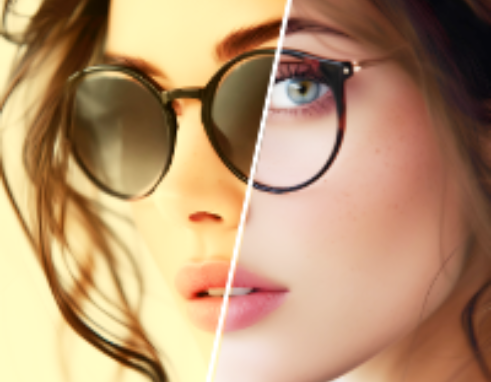Everything You Need to Know About Photochromic lenses
March 07, 2025

If you wear glasses, you might have heard about photochromic lenses . These are special glasses that change from clear to dark when exposed to sunlight and return to clear indoors. They are a great option for people who want the benefits of both regular glasses and sunglasses in one pair. Let’s explore how they work, their benefits, and whether they are the right choice for you.
How Do Photochromic Lenses Work?
Photochromic lenses contain special molecules that react to UV (ultraviolet) light. When you step outside, these molecules darken, turning your glasses into sunglasses. When you go back indoors, they return to their clear state. The speed of this transition depends on the brand and technology used, but modern lenses
change quickly—usually within seconds to a few minutes.
Benefits of Photochromic glasses —
1. Convenience
With photochromic lenses, you don’t need to carry a separate pair of sunglasses. Your glasses adjust automatically to different lighting conditions.
2. Eye Protection
They block 100% of UV rays , reducing the risk of eye problems like cataracts and macular degeneration.
3. Comfort in Different Light Conditions
If your eyes are sensitive to light, photochromic lenses help reduce strain and discomfort by adjusting to the brightness around you.
4. Cost-Effective
Instead of buying separate prescription glasses and sunglasses, you get both in one, saving money in the long run.
5. Available in Different Styles
Photochromatic lenses come in various designs, including fashionable frames , different colors, and coatings like anti-glare or blue light protection.
Are There Any Downsides?
- Slower Transition in Some Cases : Some lenses take longer to adjust in extreme temperatures or under artificial light.
- Not Always Dark in Cars : Since car windshields block UV rays, some photochromic lenses may not darken fully while driving. However, special driving lenses are available.
- Might Not Be Ideal for Indoor Use : If you work in a space with strong UV light exposure, your lenses might stay slightly tinted.
Who Should Use Photochromatic glasses?
- People who go outdoors often and need sun protection.
- Those who don’t want to carry two pairs of glasses.
- Individuals who experience eye strain from bright lights.
- People who want an all-in-one eyewear solution.
Conclusion —
Photochromatic glasses are a smart, stylish, and practical choice for many people. They adapt to changing light, protect your eyes, and save you the hassle of switching between glasses and sunglasses. If you're considering getting a pair, talk to your optician about the best options for your lifestyle.
Would you try photochromatic lenses? Let us know in the comments!
How Do Photochromic Lenses Work?
Photochromic lenses contain special molecules that react to UV (ultraviolet) light. When you step outside, these molecules darken, turning your glasses into sunglasses. When you go back indoors, they return to their clear state. The speed of this transition depends on the brand and technology used, but modern lenses
change quickly—usually within seconds to a few minutes.
Benefits of Photochromic glasses —
1. Convenience
With photochromic lenses, you don’t need to carry a separate pair of sunglasses. Your glasses adjust automatically to different lighting conditions.
2. Eye Protection
They block 100% of UV rays , reducing the risk of eye problems like cataracts and macular degeneration.
3. Comfort in Different Light Conditions
If your eyes are sensitive to light, photochromic lenses help reduce strain and discomfort by adjusting to the brightness around you.
4. Cost-Effective
Instead of buying separate prescription glasses and sunglasses, you get both in one, saving money in the long run.
5. Available in Different Styles
Photochromatic lenses come in various designs, including fashionable frames , different colors, and coatings like anti-glare or blue light protection.
Are There Any Downsides?
- Slower Transition in Some Cases : Some lenses take longer to adjust in extreme temperatures or under artificial light.
- Not Always Dark in Cars : Since car windshields block UV rays, some photochromic lenses may not darken fully while driving. However, special driving lenses are available.
- Might Not Be Ideal for Indoor Use : If you work in a space with strong UV light exposure, your lenses might stay slightly tinted.
Who Should Use Photochromatic glasses?
- People who go outdoors often and need sun protection.
- Those who don’t want to carry two pairs of glasses.
- Individuals who experience eye strain from bright lights.
- People who want an all-in-one eyewear solution.
Conclusion —
Photochromatic glasses are a smart, stylish, and practical choice for many people. They adapt to changing light, protect your eyes, and save you the hassle of switching between glasses and sunglasses. If you're considering getting a pair, talk to your optician about the best options for your lifestyle.
Would you try photochromatic lenses? Let us know in the comments!

Log In